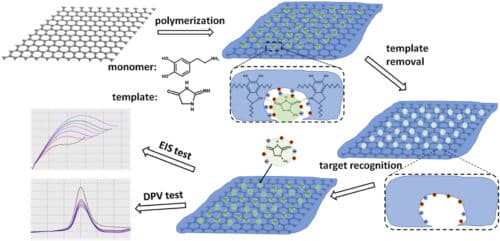Team of researchers has developed a unique MIP electrolytic biosensor that is based on the graphene nanoplatelet and polydopamine composites for creatinine detection.

Image Credits: Science Direct
The classic Jaffe colorimetry technique mixed picric acid with creatinine to generate orange-red structure which can be quantified. However, the results of this technique are not very reliable as other molecules that are pigmented, like bilirubin can mix up creatinine.
Another method uses creatinase. It is an enzyme that is used to detect creatinine with high sensitivity. However, the stability of the specimen is compromised due to the short activity duration of the enzyme. This creates a need for creating a specific and highly sensitive method to detect creatinine.
The team developed an unique approach with surface-MIP which allows more number of template molecules to be placed in a closer vicinity to the polymeric surface. This ensures that the template molecules are totally removed, resulting in a larger detection range.
With the given conditions, dopamine hydrochloride (DA) monomers self-polymerize and stick to different substrates. The GNP/PDA-MIP composite may be manufactured in a facile one-pot approach. Similarly, a coating of PDA is deposited on the GNP surface using a simple safe one-pot fabrication process.
The results showed that this approach has a better specificity and sensitivity. The graphene nanoplatelets exhibit strong conductance which has better stability. This newly proposed GNP/PDA-MIP biosensor has the notable benefit of an incredibly linear range of response and a very low LOD when compared to other existing biosensors.
This recent study presented an approach that enables a potentially non-invasive point of care (POC) detection technique for the frontline medical diagnosis. The primary goal of this biosensor is to detect the creatinine levels and is expected to enable the possibility for POC detection of other biomarkers in bodily fluids. These biosensors can be used for diagnosing a broad spectrum of illness.






